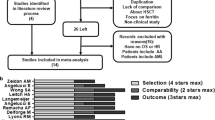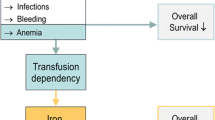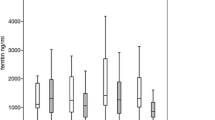Abstract
This study aimed to evaluate the evolution of iron overload, assessed by serum ferritin (SF), in transfusion-dependent lower risk patients with myelodysplastic syndrome (MDS), as well as to describe the occurrence of organ complications, and to analyze its relationship with iron chelation therapy. This observational retrospective study was conducted from March 2010 to March 2011 in 47 Spanish hospitals. A total of 263 patients with lower risk MDS (International Prognostic Scoring System [IPSS] low/intermediate-1 risk or Spanish Prognostic Index [SPI] 0–1 risk), transfusion-dependent, and who had received ≥10 packed red blood cells (PRBC) were included. At MDS diagnosis, patients received a mean of 2.8 ± 3.9 PRBC/month, and 8.7 % of patients showed SF ≥1000 μg/L. Over the course of the disease, patients received a mean of 83.4 ± 83.3 PRBC, and 36.1 % of patients presented SF ≥2500 μg/L. Cardiac, hepatic, endocrine, or arthropathy complications appeared/worsened in 20.2, 11.4, 9.9, and 3.8 % of patients, respectively. According to investigator, iron overload was a main cause of hepatic (70.0 %) and endocrine (26.9 %) complications. A total of 96 (36.5 %) patients received iron chelation therapy for ≥6 months, being deferasirox the most frequent first chelation treatment (71.9 %). Chelation-treated patients showed longer overall survival (p < 0.001), leukemia-free survival (p = 0.007), and cardiac event-free survival (p = 0.017) than non-chelated patients. In multivariable analyses, age (p = 0.011), IPSS (p < 0.001), and chelation treatment (p = 0.015) were predictors for overall survival; IPSS (p = 0.014) and transfusion frequency (p = 0.001) for leukemia-free survival; and chelation treatment (p = 0.040) and Sorror comorbidity index (p = 0.039) for cardiac event-free survival. In conclusion, these results confirm the potential survival benefit of iron chelation therapy and provide additional evidence on the deleterious effect of iron overload in lower risk MDS patients.

Similar content being viewed by others
References
Steensma DP, Bennett JM (2006) The myelodysplastic syndromes: diagnosis and treatment. Mayo Clin Proc 81(1):104–130. doi:10.4065/81.1.104
Takatoku M, Uchiyama T, Okamoto S, Kanakura Y, Sawada K, Tomonaga M, Nakao S, Nakahata T, Harada M, Murate T, Ozawa K (2007) Retrospective nationwide survey of Japanese patients with transfusion-dependent MDS and aplastic anemia highlights the negative impact of iron overload on morbidity/mortality. Eur J Haematol 78(6):487–494. doi:10.1111/j.1600-0609.2007.00842.x
Malcovati L, Della Porta G, Cazzola M (2006) Predicting survival and leukemic evolution in patients with myelodysplastic syndrome. Haematologica 91(12):1588–1590
Malcovati L, Porta MG, Pascutto C, Invernizzi R, Boni M, Travaglino E, Passamonti F, Arcaini L, Maffioli M, Bernasconi P, Lazzarino M, Cazzola M (2005) Prognostic factors and life expectancy in myelodysplastic syndromes classified according to WHO criteria: a basis for clinical decision making. J Clin Oncol 23(30):7594–7603. doi:10.1200/JCO.2005.01.7038
Greenberg P, Cox C, LeBeau MM, Fenaux P, Morel P, Sanz G, Sanz M, Vallespi T, Hamblin T, Oscier D, Ohyashiki K, Toyama K, Aul C, Mufti G, Bennett J (1997) International scoring system for evaluating prognosis in myelodysplastic syndromes. Blood 89(6):2079–2088
Bennett JM, Catovsky D, Daniel MÄ, Flandrin G, Galton D, Gralnick HT, Sultan C (1982) Proposals for the classification of the myelodysplasic syndromes. Br J Haematol 51(2):189–199
Sanz GF, Sanz MA, Vallespi T, Canizo MC, Torrabadella M, Garcia S, Irriguible D, San Miguel JF (1989) Two regression models and a scoring system for predicting survival and planning treatment in myelodysplastic syndromes: a multivariate analysis of prognostic factors in 370 patients. Blood 74(1):395–408
Rose C, Brechignac S, Vassilief D, Pascal L, Stamatoullas A, Guerci A, Larbaa D, Dreyfus F, Beyne-Rauzy O, Chaury MP, Roy L, Cheze S, Morel P, Fenaux P (2010) Does iron chelation therapy improve survival in regularly transfused lower risk MDS patients? A multicenter study by the GFM (Groupe Francophone des Myelodysplasies). Leuk Res 34(7):864–870. doi:10.1016/j.leukres.2009.12.004
Neukirchen J, Fox F, Kundgen A, Nachtkamp K, Strupp C, Haas R, Germing U, Gattermann N (2012) Improved survival in MDS patients receiving iron chelation therapy—a matched pair analysis of 188 patients from the Dusseldorf MDS registry. Leuk Res 36(8):1067–1070. doi:10.1016/j.leukres.2012.04.006
Komrokji RS, Al Ali NH, Padron E, Lancet JE, List AF (2011) Impact of iron chelation therapy on overall survival and AML transformation in lower risk MDS Patients treated at the Moffitt Cancer Center. Blood 118(21):1196–1197
Leitch HA (2007) Improving clinical outcome in patients with myelodysplastic syndrome and iron overload using iron chelation therapy. Leuk Res 31(Suppl 3):S7–9. doi:10.1016/S0145-2126(07)70460-5
Lyons RM, Marek BJ, Sharma S, Paley C, Esposito J, Garbo L, DiBella N, Garcia-Manero G (2011) 24-month analysis of the impact of chelation on clinical outcomes in a 600 patient registry of lower-risk MDS patients. Blood 118(21):1207–1208
Porter JB (2001) Practical management of iron overload. Br J Haematol 115(2):239–252
Dreyfus F (2008) The deleterious effects of iron overload in patients with myelodysplastic syndromes. Blood Rev 22(Suppl 2):S29–34. doi:10.1016/S0268-960X(08)70006-7
Gattermann N (2012) Pathophysiological and clinical aspects of iron chelation therapy in MDS. Curr Pharm Des 18(22):3222–3234
Goldberg SL (2007) Novel treatment options for transfusional iron overload in patients with myelodysplastic syndromes. Leuk Res 31(Suppl 3):S16–22. doi:10.1016/S0145-2126(07)70462-9
Leitch HA (2011) Controversies surrounding iron chelation therapy for MDS. Blood Rev 25(1):17–31. doi:10.1016/j.blre.2010.09.003
Della Porta MG, Malcovati L, Travaglino E, Pascutto C, Maffioli M, Invernizzi R, Cazzola M (2007) A prognostic model for predicting the impact of comorbidities on survival of patients with myelodysplastic syndromes. Blood 110(11), abstract 24103
Della Porta G, Kuendgen A, Malcovati L, Zipperer E, Pascutto C, Travaglino E (2008) Myelodysplastic syndrome (MDS)-specific comorbidity index for predicting the impact of extra-hematological comorbidities on survival of patients with MDS. Blood 112(11):925–926a
WHO classification of tumours (2008) In: Swerdlow SH, Campo E, Harris NL et al (eds) WHO classification of tumours of hematopoietic and lymphoid tissues. IARC Press, Lyon, pp 109–138
Germing U, Aul C, Niemeyer CM, Haas R, Bennett JM (2008) Epidemiology, classification and prognosis of adults and children with myelodysplastic syndromes. Ann Hematol 87(9):691–699. doi:10.1007/s00277-008-0499-3
Sorror ML, Maris MB, Storb R, Baron F, Sandmaier BM, Maloney DG, Storer B (2005) Hematopoietic cell transplantation (HCT)-specific comorbidity index: a new tool for risk assessment before allogeneic HCT. Blood 106(8):2912–2919. doi:10.1182/blood-2005-05-2004
Gattermann N (2007) Guidelines on iron chelation therapy in patients with myelodysplastic syndromes and transfusional iron overload. Leuk Res 31(Suppl 3):S10–15. doi:10.1016/S0145-2126(07)70461-7
Gattermann N (2008) Overview of guidelines on iron chelation therapy in patients with myelodysplastic syndromes and transfusional iron overload. Int J Hematol 88(1):24–29. doi:10.1007/s12185-008-0118-z
Harris NL, Jaffe ES, Diebold J, Flandrin G, Muller-Hermelink HK, Vardiman J, Lister TA, Bloomfield CD (1999) World Health Organization classification of neoplastic diseases of the hematopoietic and lymphoid tissues: report of the Clinical Advisory Committee meeting-Airlie House, Virginia, November 1997. J Clin Oncol 17(12):3835–3849
Remacha AF, Arrizabalaga B, Del Canizo C, Sanz G, Villegas A (2010) Iron overload and chelation therapy in patients with low-risk myelodysplastic syndromes with transfusion requirements. Ann Hematol 89(2):147–154. doi:10.1007/s00277-009-0794-7
Komrokyi R, Al Ali N, Padras E (2011) Impact of iron chelation therapy on overall survival and AML transformation in lower risk MDS patients treated at the Moffitt Cancer Centre. Blood 118:2776
Goldberg SL, Chen E, Corral M, Guo A, Mody-Patel N, Pecora AL, Laouri M (2010) Incidence and clinical complications of myelodysplastic syndromes among United States Medicare beneficiaries. J Clin Oncol 28(17):2847–2852. doi:10.1200/JCO.2009.25.2395
Delforge M, Selleslag D, Beguin Y, Triffet A, Mineur P, Theunissen K, Graux C, Trullemans F, Boulet D, Van Eygen K, Noens L, Van Steenweghen S, Lemmens J, Pierre P, D’Hondt R, Ferrant A, Deeren D, Van De Velde A, Wynendaele W, Andre M, De Bock R, Efira A, Breems D, Deweweire A, Geldhof K, Pluymers W, Harrington A, MacDonald K, Abraham I, Ravoet C (2014) Adequate iron chelation therapy for at least six months improves survival in transfusion-dependent patients with lower risk myelodysplastic syndromes. Leuk Res 38(5):557–563. doi:10.1016/j.leukres.2014.02.003
Lyons RM, Marek BJ, Paley C, Esposito J, Garbo L, DiBella N, Garcia-Manero G (2014) Comparison of 24-month outcomes in chelated and non-chelated lower-risk patients with myelodysplastic syndromes in a prospective registry. Leuk Res 38(2):149–154. doi:10.1016/j.leukres.2013.11.004
Malcovati L, Germing U, Kuendgen A, Della Porta MG, Pascutto C, Invernizzi R, Giagounidis A, Hildebrandt B, Bernasconi P, Knipp S, Strupp C, Lazzarino M, Aul C, Cazzola M (2007) Time-dependent prognostic scoring system for predicting survival and leukemic evolution in myelodysplastic syndromes. J Clin Oncol 25(23):3503–3510. doi:10.1200/JCO.2006.08.5696
Leitch HA (2011) Optimizing therapy for iron overload in the myelodysplastic syndromes: recent developments. Drugs 71(2):155–177. doi:10.2165/11585280-000000000-00000
Sanz G, Nomdedeu B, Such E, Bernal T, Belkaid M, Ardanaz T, Cervera J (2008) Independent impact of iron overload and transfusion dependency on survival and leukemic evolution in patients with myelodysplastic syndrome. Blood 112(11):238–239a
Wang R, Gross CP, Halene S, Ma X (2009) Comorbidities and survival in a large cohort of patients with newly diagnosed myelodysplastic syndromes. Leuk Res 33(12):1594–1598. doi:10.1016/j.leukres.2009.02.005
Della Porta G, Malcovati L (2009) Clinical relevance of extra-hematological comorbidity in the management of patients with myelodysplastic syndrome. Haematologica 94(5):602–606
Hoffbrand AV, Taher A, Cappellini MD (2012) How I treat transfusional iron overload. Blood 120(18):3657–3669. doi:10.1182/blood-2012-05-370098
Buja LM, Roberts WC (1971) Iron in the heart. Etiology and clinical significance. Am J Med 51(2):209–221
Hellstrom-Lindberg E (2005) Management of anemia associated with myelodysplastic syndrome. Semin Hematol 42(2 Suppl 1):S10–13
Gattermann N (2010) How to treat MDS without stem cell transplantation. Biol Blood Marrow Transplant 16(1 Suppl):S30–36. doi:10.1016/j.bbmt.2009.10.017
Acknowledgments
This study was funded by Novartis Farmacéutica, S.A, Spain. The authors would like to acknowledge the remaining investigators participating in the IRON-2 Study: Juan Antonio Muñoz Muñoz (Hospital Universitario Puerta del Mar, Spain), Rafael Franco Osorio (Hospital Punta de Europa, Spain), Luis Palomera Bernal (Hospital Clínico Universitario Lozano Blesa, Spain), Gemma Azaceta Reinares (Hospital Clínico Universitario Lozano Blesa, Spain), Jose Antonio Moreno Chulilla (Hospital Clínico Universitario Lozano Blesa, Spain), Ana Díaz Trapiella (Hospital de Cabueñes, Spain), Teresa Bernal del Castillo (Hospital Universitario Central de Asturias, Spain), María Antonia Durán Pastor (Hospital Universitario Son Dureta, Spain), Joan Bargay Lleonart (Hospital Sont Llatzer, Spain), Antonia Cladera Sierra (Hospital Sont Llatzer, Spain), Jose María Guerra Hernando (Hospital Sont Llatzer, Spain), Martín Mascaró Riera (Hospital Sont Llatzer, Spain), Angelina Lemes Castellano (Hospital Universitario de Gran Canaria Doctor Negrín, Spain), Bernardo Javier González González (Hospital Universitario de Canarias, Spain), María Cristina Fernández Jimenez (Complejo Hospitalario de Toledo, Spain), Consuelo del Cañizo (Hospital Universitario de Salamanca, Spain), Marcos Barbón Fernández (Hospital de León, Spain), Laura Vicente Folch (Consorci Sanitari Terrassa, Spain), Jaume Orriols Bernet (Fundació Althaia Manresa, Spain), Albert Altés (Fundació Althaia Manresa, Spain), Elena Cabezudo (Fundació Althaia Manresa, Spain), María Esther Plensa Alberca (Hospital de Mataró, Spain), Albert Soley i Garasa (Hospital de Mataró, Spain), Blanca Xicoy Cirici (Hospital Universitari Germans Trias i Pujol, Spain), Alfonso Soler Campos (Hospital Universitari Parc Taulí, Spain), Salut Brunet (Hospital de la Santa Creu i Sant Pau, Spain), Javier Bueno Aribayos (Hospital Vall d’Hebron, Spain), Esther Sancho (Hospital Vall d’Hebron, Spain), David Gallardo Giralt (Hospital Universitari de Girona Doctor Josep Trueta, Instituto Catalán de Oncologia de Girona, Spain), Armando Luaña Galán (Hospital Universitari Arnau de Vilanova, Spain), Andreu Llorente Cabrera (Hospital Universitari Joan XXIII, Spain), Joan Cid Vidal (Hospital Universitari Joan XXIII, Spain), Rafael Andreu Lapiedra (Hospital Universitario Doctor Peset, Spain), Elena Gómez Beltran (Hospital Universitario Doctor Peset, Spain), Carlos Fernández Lago (Complejo Hospitalario Universitario Juan Canalejo, Spain), Beatriz Pazos García (Complejo Hospitalario Universitario Juan Canalejo, Spain), María Angeles Bendaña López (Hospital Clínico Universitario de Santiago Compostela, Spain), Aida Fernández Montero (Hospital Clínico Universitario de Santiago Compostela, Spain), Beatriz Antelo Rodríguez (Hospital Clínico Universitario de Santiago Compostela, Spain), Jose Luis Bello López (Hospital Clínico Universitario de Santiago Compostela, Spain), Manuel Mateo Pérez Encinas (Hospital Clínico Universitario de Santiago Compostela, Spain), María José Rabuñal Martínez (Hospital Clínico Universitario de Santiago Compostela, Spain), Mercedes Castro Mouzo (Complejo Hospitalario de Vigo, Hospital Xeral-Cíes, Spain), Jose María Lapeña Aznar (Hospital San Pedro, Spain), Celina Benavente Cuesta (Hospital Clínico Universitario San Carlos, Spain), Fernándo Ataulfo González Fernández (Hospital Clínico Universitario San Carlos, Spain), Valle Gómez García de Soria (Hospital Universitario de La Princesa, Spain), Santiago Osorio Prendes (Hospital General Universitario Gregorio Marañón, Spain), Alejandro del Castillo Rueda (Hospital General Universitario Gregorio Marañón, Spain), Teresa Pascual Garcia (Hospital Universitario Príncipe de Asturias, Spain), Helga Gullén García (Hospital Universitario Príncipe de Asturias, Spain), Marta Barrionuevo González (Hospital Universitario Príncipe de Asturias, Spain), Emilio Ojeda Gutierrez (Hospital Universitario Puerta del Hierro Majadahonda, Spain), María Dolores López García-Carreño (Hospital General Universitario Santa María del Rosell, Spain), Izaskun Ceberio (Hospital de Navarra, Spain), Saioa Zalba Marcos (Hospital de Navarra, Spain), Carmen Menchaca Echevarría (Hospital Txagorritxu, Spain), Arantza Mendizábal Abad (Hospital Txagorritxu, Spain), Ernesto Pérez Persona (Hospital Txagorritxu, Spain), Jose María Guinea de Castro (Hospital Txagorritxu, Spain), María Teresa Viniegra Ros (Hospital Txagorritxu, Spain), Teresa Uranga (Hospital Universitario Donostia, Spain), Maialen Sirvent Auzmendi (Hospital Universitario Donostia, Spain), Cristina Martínez Bilbao (Hospital Galdakao-Usansolo, Spain), Cristina Cortés (Hospital Galdakao-Usansolo, Spain), Garazi Letamendi Madariaga (Hospital Galdakao-Usansolo, Spain), Jesús Ojanguren (Hospital Galdakao-Usansolo, Spain), Jose Enrique de la Puerta Rueda (Hospital Galdakao-Usansolo, Spain), Koldo Atucha Aresti (Hospital Galdakao-Usansolo, Spain), Tomás Carrascosa Vallejo (Hospital Galdakao-Usansolo, Spain), Jose María Beltrán de Heredia (Hospital de Basurto, Spain), Itziar Olabarría Santurtun (Hospital de Basurto, Spain), Jose Antonio Marquez Navarro (Hospital de Basurto, Spain), María Victoria García Menoyo (Hospital de Basurto, Spain), Pilar Aragues (Hospital Universitario Cruces, Spain), and Sara Erkiaga (Hospital Universitario Cruces, Spain).
Ethical standards
This study was conducted in accordance with the Guidelines for Ethical Review of Epidemiological Studies, Spanish Society of Epidemiology, the principles of the Helsinki Declaration, and its subsequent amendments. The study was approved by the Ethics Committee from Hospital Clínico Universitario San Carlos (Madrid, Spain). Written informed consent was obtained from patients prior to their inclusion in the study. All procedures followed were in accordance with the ethical standards of the responsible committee on human experimentation, and with the Helsinki Declaration of 1975 and its later revisions.
Conflict of interest
The authors declare that Dr. Maria Diez Campelo has received research funding and honoraria from Novartis; and Dr. Guillermo Sanz has received research funding from Celgene and Novartis, and serves as a consultant to Celgene, Amgen, Novartis and Boehringer Ingelheim Pharma GmbH. The remaining authors have no conflict of interest to disclose.
Author information
Authors and Affiliations
Consortia
Corresponding author
Rights and permissions
About this article
Cite this article
Remacha, Á.F., Arrizabalaga, B., Villegas, A. et al. Evolution of iron overload in patients with low-risk myelodysplastic syndrome: iron chelation therapy and organ complications. Ann Hematol 94, 779–787 (2015). https://doi.org/10.1007/s00277-014-2274-y
Received:
Accepted:
Published:
Issue Date:
DOI: https://doi.org/10.1007/s00277-014-2274-y




